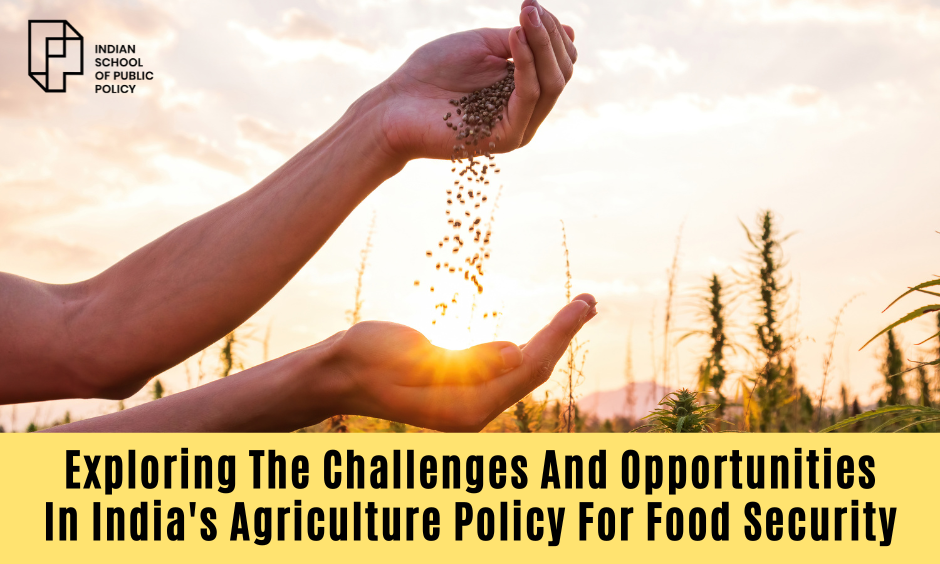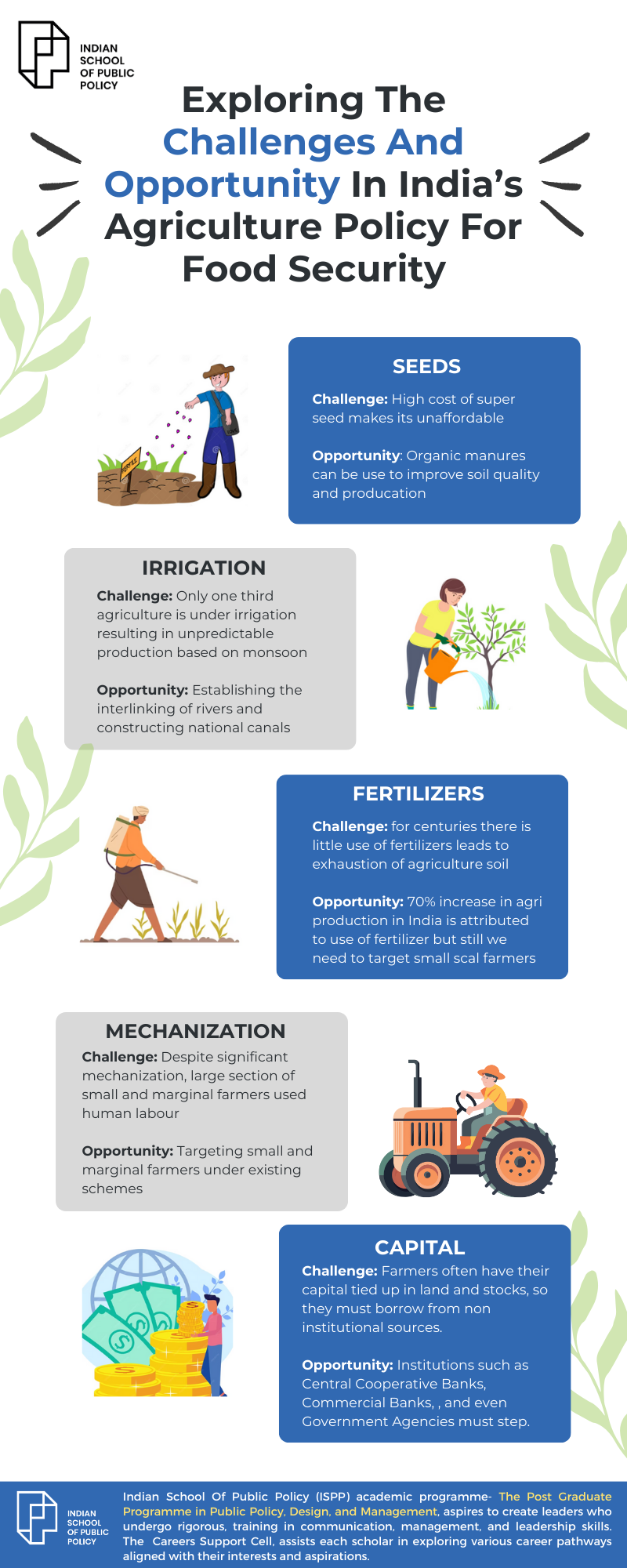
Exploring The Challenges And Opportunities In India’s Agriculture Policy For Food Security

A few decades ago, India’s agriculture industry was the backbone of its economy, contributing a staggering 75% to the country’s GDP. Fast forward to the present day, and this number has dwindled to a mere 18.3% (2022-2023). This transformation showcases a shift in India’s economic landscape and has brought along a set of multifaceted challenges that necessitate a critical review of the country’s agriculture policy, particularly concerning food security.
As per the findings of the Global Food Security Index 2022, India has a 16.3% prevalence of undernutrition. Considering this, agriculture plays a crucial role in the nation’s pursuit of achieving its food security objectives. The provision of safe and nutritious food has been a paramount concern for governments throughout history, including in India.
Issues in India’s Agriculture Policy
Despite being one of the largest food producers globally, India continues to grapple with food insecurity. Millions of citizens still lack access to sufficient, safe, and nutritious food. This paradox highlights the need for a robust and effective agriculture policy that can address the issues. Amidst the following challenges lie promising opportunities for improvement that can transform India’s agriculture landscape.
Seeds
Seeds are a crucial component in enhancing crop yields and ensuring consistent growth in agricultural output. Providing seeds of guaranteed quality is just as important as manufacturing them. Unfortunately, the high cost of superior seeds makes it challenging for farmers to afford them, which is one of the major obstacles faced by the Indian agriculture sector.
Opportunity for Improvement
Organic manures are considered crucial for maintaining healthy soil. Currently, there is an underutilisation of the country’s potential 650 million tonnes of rural compost and 160 lakh tonnes of urban compost. By harnessing this potential, both the issues of waste disposal and soil fertilisation can be addressed. The government has implemented heavy subsidies to promote the use of chemical fertilisers as an incentive. During the period of Independence, chemical fertilisers were rarely used, but through government actions and the mindset shift of some progressive farmers, their usage has significantly increased. Biocides are employed to protect crops and prevent losses. The increased usage of these inputs has successfully prevented many unnecessary crop losses, especially in food crops. However, the extensive use of biocides has resulted in environmental contamination, which has its own associated costs.
Irrigation
India, the world’s second-largest irrigated nation after China, only has one-third of its cropland irrigated. This is a significant limitation considering the country’s tropical monsoon climate, which results in unpredictable and variable rainfall. In order to achieve substantial agricultural progress, it is essential to have reliable irrigation covering more than 50% of the cultivated area.
The Little Ray Of Hope
The notable success in agricultural development seen in Punjab, Haryana, and the western part of Uttar Pradesh is primarily attributed to the fact that over half of the cultivated land in these regions is under irrigation. To further enhance agricultural productivity, large tracts of land still require irrigation. By promoting interstate cooperation on water management, the maximum potential of water resources can be realised and distributed efficiently to areas where it is most needed. Establishing the interlinking of rivers, as well as constructing national canals and channels, can strengthen irrigation systems and provide support to farmers in case of monsoon failure.
Fertilisers and Manures
For centuries, Indian soils have been used to grow crops without much consideration for replenishment. As a result, the soils have become exhausted and depleted, leading to decreased yields. In fact, the average crop yields in India are among the lowest in the world. To address this significant issue, it is crucial to increase the use of manures and fertilisers.
Scope For Improvement
Manures and fertilisers play a similar role for soils as healthy food does for the human body. Just as a well-nourished person can perform tasks competently, nourished soil can yield good harvests. Approximately 70% of the growth in agricultural output is attributed to the increased application of fertilisers. Hence, the use of fertilisers can be seen as an indicator of agricultural prosperity. However, ensuring an adequate supply of manures and fertilisers throughout a large country like India, where there is a significant population of low-income farmers, presents a challenge. Chemical fertilisers, in particular, tend to be expensive and often unaffordable for small-scale farmers. Hence, the fertiliser issue is both serious and complex.
Lack Of Mechanisation
Despite significant mechanisation in certain regions of the country, a large portion of agricultural operations in these areas is still carried out manually using basic tools and implements such as wooden ploughs and sickles.
Tasks like ploughing, seeding, irrigating, thinning and pruning, weeding, harvesting, threshing, and transporting crops are performed without the use of machinery or with minimal machinery involvement. This is especially true for small and marginal farms. As a result, a large amount of human labor is required, leading to low productivity per worker.
Addressing This Issue
Supporting youth involvement in farming and related fields can help address this issue. With their existing core institutional education and expertise, young individuals can quickly learn and develop in these areas.
Furthermore, equipping small farmers with advanced machinery and modern technology can significantly improve productivity, quality, and efficiency. There have been efforts to mechanise agriculture in India since independence, with the Green Revolution in the 1960s highlighting the importance of mechanisation. Various programmes and initiatives have been introduced to encourage farmers to adopt modern methods and replace traditional and inefficient practices with advanced machinery.
Capital
Agriculture, like other industries, requires capital to operate effectively. As agricultural technology advances, the need for financial investment becomes increasingly important. Farmers often have their capital tied up in land and stocks, so they must borrow money to enhance agricultural output. Unfortunately, in rural areas, money lenders, traders, and commission agents often serve as the primary sources of funding for farmers, charging exorbitant interest rates and purchasing agricultural products at low prices.
Resolution
Despite their monopolistic position, these lenders remain the sole providers of agricultural loans. However, there is a pressing need to transform the rural finance landscape. Institutions such as Central Cooperative Banks, State Cooperative Banks, Commercial Banks, Cooperative Credit Agencies, and even Government Agencies must step in to offer farmers loans with favourable terms. This significant change will empower farmers and help them access financing options that better serve their needs.
The Dire Need For Skilled Policymakers
As India navigates the evolving dynamics of its agriculture sector, the challenges and opportunities within its agriculture policy for food security become increasingly evident. With the right blend of innovation, technology, and policy reform, the agriculture sector can regain its strength while ensuring food security for all citizens. However, this transformation requires the collective efforts of industry players, citizens, and most of all – the expertise of skilled policymakers.
Where can policymakers/policy aspirants gain expertise?
Register your Interest to Study at ISPP
PDM By Indian School Of Public Policy
The ISPP’s flagship program, the Post Graduate Programme in Public Policy, Design, and Management serves as an ideal platform for aspirants committed to influencing the realm of public policy. Spanning over one year, this programme delves deep into the art and science of policymaking through a comprehensive curriculum structured into seven terms, each spanning 7 weeks. A pivotal component of this programme is the Capstone Exercise, where scholars engage in tackling present-day policy dilemmas, leveraging inventive policy measures. Beyond the academic framework, the ISPP PDM Programme also facilitates extensive networking prospects, participation in professional forums, and dedicated assistance for career development and placements.
Programme Highlights
The programme offers a deep grasp of public policy and imparts design and management concepts to help students become better at thinking about systems and working as policy leaders. Along with studying policy analysis and development, students will understand how to consider real-world aspects like money, skills, and ethics. The programme strongly emphasises learning the best ways to put policies into action, manage them, and evaluate their impact in public administration and policy areas.
- HARRIS UCHICAGO: CERTIFICATE IN PUBLIC POLICY
- IMMERSIVE LEARNING PROJECTS
- INTERACTIVE LABS
- CAREER SUPPORT & PLACEMENTS
- TEA & POLICY
Academic Pedagogy
At ISPP, learning focuses on skills, ethics, and leadership to develop experts who can make a difference. The courses include classroom study, skill development, practical application, and training in leadership and management. The curriculum covers basic, core, and extra courses.
Learn more about the curriculum here.
Student Testimonials


FAQs
What is the current status of India’s agriculture policy for food security?
India’s agriculture policy is facing several challenges, including issues like low agricultural productivity, water scarcity, and inadequate infrastructure. These challenges have made it difficult to ensure food security for the growing population.
How can India address the challenges in its agriculture policy?
India can address these challenges through investments in modern agricultural technologies, improved irrigation systems, and better market access for farmers. Additionally, implementing sustainable farming practices and providing support to small-scale farmers can contribute to overcoming these challenges.
What opportunities exist in India’s agriculture policy for food security?
Opportunities in India’s agriculture policy include leveraging technology for precision agriculture, promoting organic farming, and increasing investment in agribusiness. Embracing climate-resilient crops and sustainable farming practices can also enhance food security.
How can India balance food security with environmental sustainability?
India can strike a balance by adopting eco-friendly farming practices, reducing post-harvest food wastage, and promoting biodiversity. Implementing policies that encourage sustainable agriculture while ensuring food production meets the population’s needs is key.
What role can government policies play in addressing food security challenges?
Government policies can incentivize farmers to adopt modern techniques, invest in research and development for crop improvement, and establish efficient food distribution systems. These policies, when well-implemented, can significantly contribute to ensuring food security in India.
Infographic



